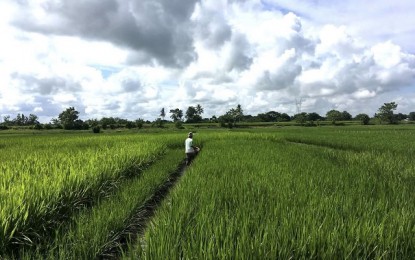
GOOD FARMING PRACTICES. A farmer from the Science City of Muñoz, Nueva Ecija has been enjoying high palay yields since 2020 due to good farming practices recommended by the Philippine Rice Research Institute. He also attributed his higher production to high-quality seeds. (Photo courtesy of PhilRice)
SCIENCE CITY OF MUÑOZ, Nueva Ecija – A farmer in this city has credited good farming practices for having high palay yields since 2020.
Alex Audencial,56, of Barangay Maligaya here, said this season, he harvested 143 cavans of palay from his 0.7-hectare farm and sold the grains for PHP17 per kilo, gaining a profit of PHP70,000.
He said he has been having higher yield compared to previous years, which he attributed to good farming practices that include strict farm monitoring.
“Religiously monitoring the field is very important in rice farming. It is the key to attending to the needs of the rice crops at the right time,” Audencial said in a social media post on Thursday.
He said that with close monitoring, spraying of pesticide is only done when needed, noting that the Department of Agriculture-Philippine Rice Research Institute (DA-PhilRice) has advised against excessive chemical application based on agroecosystem analysis.
“Let us also give the right fertilizers in their right amount for the rice crop to yield more, and avoid reducing the amount because the harvest will also be reduced. Manage the pests and weeds well,” Audencial said in advising other palay farmers.
To determine the right amount of fertilizers to apply, he said that DA-PhilRice recommended the use of Leaf Color Chart (LCC), Minus-One-Element Technique (MOET), Nutrient-Omission-Plot Technique (NOPT), and Rice Crop Manager (RCM).
LCC is a tool to visually assess the nitrogen status of the rice crop while MOET is a pot experiment that is complemented with an ICT-based application to determine the nutrients deficient in the soil and the amounts needed for a certain target yield.
NOPT is a means to assess indigenous nutrient supply to serve as the basis of fertilizer recommendation, and RCM is an ICT-based platform for rapidly deploying improved nutrient and rice-farming management technologies.
Audencial also said he planted the NSIC Rc 222 rice variety, which has an average yield of 6.1 tons per hectare (t/ha.) and maximum of 10 t/ha., and is moderately resistant to the brown plant hopper and green leafhopper pests.
“It is also important to use high-quality seeds, which helps in increasing yield,” he said, adding that he also practices synchronous planting and fallow period.
Rice experts said a month-long fallow period or soil rest goes hand-in-hand with synchronous planting. This practice breaks the average life cycle of insect pests that is usually at 30 days and destroys disease hosts before the next cropping season begins. (PNA)
